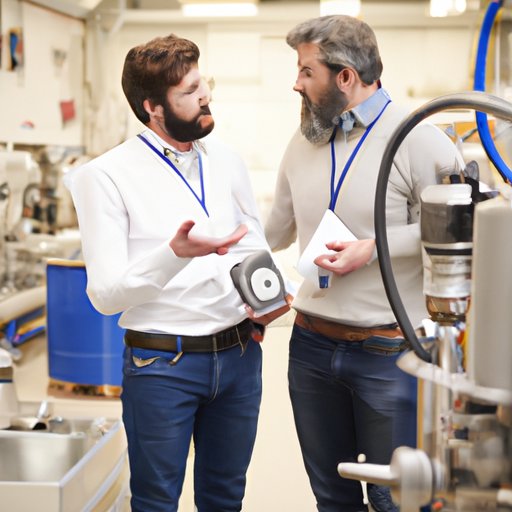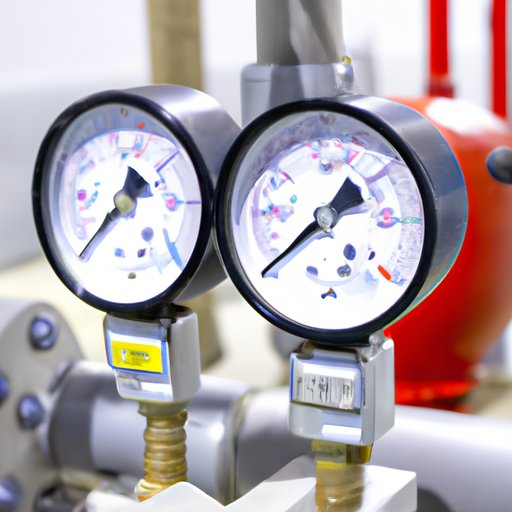Introduction
A pressure transducer is a device that measures and converts pressure into an electrical signal. It is commonly used in industrial and scientific applications, such as in process control systems, to measure and monitor pressures in pipes and tanks. Pressure transducers are also used in medical equipment, air data systems, automotive systems, and other applications where accurate pressure measurements are needed.
What is a Pressure Transducer?
A pressure transducer is a device that measures and converts pressure into an electrical signal. The transducer uses a diaphragm or other sensing element to detect changes in pressure. This change in pressure is then converted into an electrical signal which can be read by a computer or other device. Pressure transducers are typically used in industrial and scientific applications, such as in process control systems, to measure and monitor pressures in pipes and tanks.

Overview of the Purpose of Pressure Transducers
The purpose of a pressure transducer is to measure and convert pressure into an electrical signal. Pressure transducers are used in many different industries and applications, including medical equipment, air data systems, automotive systems, and other applications where accurate pressure measurements are needed. Pressure transducers are also used in process control systems to measure and monitor pressures in pipes and tanks.
Explaining the Basic Functionality of Pressure Transducers
Pressure transducers are designed to measure pressure, which is defined as the force exerted on a surface per unit area. When pressure is applied to a transducer, it causes a diaphragm or other sensing element inside the device to move. This movement is then converted into an electrical signal, which can be read by a computer or other device.
Examining the Internal Components of a Pressure Transducer
A pressure transducer consists of several internal components. These components include a sensing element, such as a diaphragm, a strain gauge, a resistor, and an amplifier. The sensing element is responsible for detecting changes in pressure. The strain gauge is used to measure the strain on the sensing element. The resistor is used to convert the strain into an electrical signal, and the amplifier is used to amplify the signal so it can be read by a computer or other device.

Describing How a Pressure Transducer Converts Pressure into an Electrical Signal
When pressure is applied to the sensing element of a pressure transducer, it causes the element to move. This movement is then converted into an electrical signal by the strain gauge, resistor, and amplifier. The electrical signal is then sent to a computer or other device, which can use the signal to measure and monitor pressure levels. Possible sources of error in the conversion process include temperature variations, mechanical strain, and electrical noise.
Outlining the Different Types of Pressure Transducers Available
There are several different types of pressure transducers available, each with its own advantages and disadvantages. The most common types are absolute pressure transducers, gauge pressure transducers, and differential pressure transducers. Absolute pressure transducers measure pressure relative to a perfect vacuum. Gauge pressure transducers measure pressure relative to atmospheric pressure. Differential pressure transducers measure the difference between two pressures. Each type has its own specific advantages and disadvantages, and should be chosen based on the application.

Discussing the Advantages and Disadvantages of Pressure Transducers
Using pressure transducers has both advantages and disadvantages. The primary benefit of using a pressure transducer is accuracy. Pressure transducers are capable of providing highly accurate readings, which makes them ideal for measuring and monitoring pressure levels in industrial and scientific applications. On the other hand, pressure transducers are generally more expensive than other methods of measuring pressure, such as thermometers or barometers. Additionally, they require regular calibration and maintenance in order to ensure accuracy.

Demonstrating How to Install and Maintain a Pressure Transducer
Installing a pressure transducer requires careful attention to detail. First, the transducer must be securely mounted to a rigid surface. The mounting surface should be level and free from vibration. Once the transducer is securely mounted, it should be connected to the appropriate power source and calibrated. Finally, the transducer should be tested for accuracy. To ensure accuracy, the transducer should be regularly inspected and recalibrated as needed.
Providing Examples of Common Applications for Pressure Transducers
Pressure transducers are used in a variety of applications, including process control systems, medical equipment, air data systems, automotive systems, and other industrial and scientific uses. In process control systems, pressure transducers are used to measure and monitor the pressure of fluids in pipes and tanks. In medical equipment, they can be used to measure blood pressure. In air data systems, they can be used to measure airspeed, altitude, and other environmental factors. In automotive systems, they can be used to measure fuel pressure, oil pressure, and other parameters.
Conclusion
A pressure transducer is a device that measures and converts pressure into an electrical signal. It is commonly used in industrial and scientific applications, such as in process control systems, to measure and monitor pressures in pipes and tanks. Pressure transducers have many advantages, such as accuracy, but also have some drawbacks, such as cost and maintenance requirements. Proper installation and maintenance of pressure transducers is essential for ensuring accuracy and reliability. In addition, there are several different types of pressure transducers available, each with its own advantages and disadvantages.
This article has provided an overview of pressure transducers, including their components, functionality, common uses, and how to install and maintain them. For more information on pressure transducers, please refer to the resources listed below.
(Note: Is this article not meeting your expectations? Do you have knowledge or insights to share? Unlock new opportunities and expand your reach by joining our authors team. Click Registration to join us and share your expertise with our readers.)
